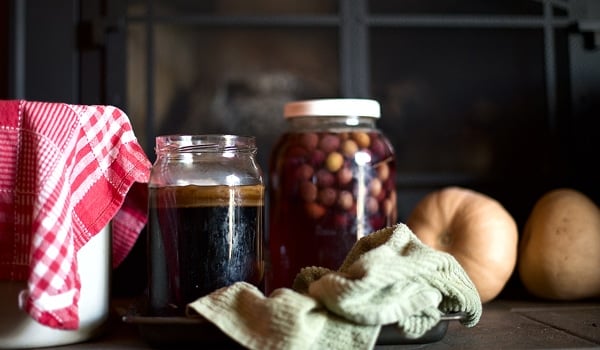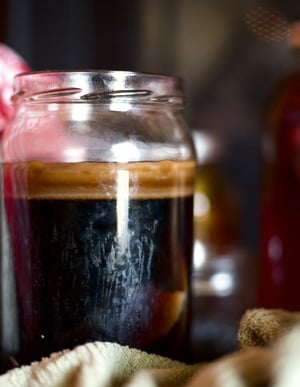As an Amazon Associate I earn from qualifying purchases.

Beer vinegar.
Let those words hang in the air for a moment. Such a simple thing, so obvious… but chances are you’ve never seen it. Beer vinegar is a close cousin to malt vinegar, which you probably have encountered, at least with your fish and chips. The biggest difference is your base product.
Malt vinegar is made from malted barley allowed to kinda-sorta become an ale. Beer vinegar is made from finished beers of all types, and the character of those beers carries through in the finished vinegar. (It is the key to my recipe for Duck Breast with Beer Sauce.)

It’s freakin’ amazing. First of all, you have so many different beers to choose from. Vinegar made from Budweiser will be different from vinegar made from Guinness, or from an India pale ale or a porter or a lambic or a Belgian tripel… you get my point.
Red wine vinegar is pretty much red wine vinegar. Yes, there are good examples and bad ones, but there’s a certain sameness to them all.
The diversity of beer vinegar is more like that between red wine and white wine vinegar. Come to think of it, beer is even more diverse than wine.
And what’s more: Beer is the perfect medium to make vinegar.
If you’ve ever made wine vinegar, you might notice that some wines are simply too strong for the acetic acid bacteria to handle. I’ve been making red wine vinegar for several years and I always find that I need to dilute it with water to lower the alcohol content, otherwise the “mother” won’t take. Beer, however, is typically 3.2 percent to 12 percent alcohol, with most good ones around 6 percent or so. Perfect.
How do you make beer vinegar?
Easy. Get yourself a big, wide-mouthed jar, or better yet, a stoneware 1 gallon pickling crock, or hell, get a two-gallon crock if you plan on making lots of vinegar. Pour some beer in there and add a vinegar mother. The mother I just linked to is a nice, neutral one, but honestly it doesn’t matter if the mother came from red wine or white wine. They’ll all work. Only thing is that a red wine vinegar mother will be, well, red, and so you might not want to drop it into a nice, light-colored pilsner vinegar. I used my red wine mother for this dark beer vinegar and it came out fine. And notice that it changed color to match that of the dark beer?
What beer did I use here? Black lager. I’ve also made it with porter and with a pilsner. All very different, all very good.
Once you drop the mother into the crock, cover it with a towel and set it in a dark place at room temperature or warmer. I’ve done some at 100°F and they loved it. Vinegar needs air, remember, so don’t seal the crock or jar. And yes, it will smell like vinegar, so maybe the hearth isn’t the best place for yours. Holly is used to my “Hanksperiments,” and is pretty tolerant…
Don’t have a vinegar mother? Well, if you are sporty, you can let nature do it. Or, rather nature’s little vinegar helpers, the fruit fly. Yep. Keep the beer outside and let the fruit flies land on it. Once you see a couple dead ones on the beer, now you can cover the crock and continue on your way.
Fruit flies have acetobacter bacteria all over their feet, and will transfer that bacteria to your beer. Don’t worry: Once the vinegar is ready, it will be so acidic it will be safe to use. You might want to strain out the dead fruit flies, though…

Now, wait. It takes a month or two for the vinegar to really be ready, depending on how large a batch you are making. Taste after a month. Also, watch for the mother to sink. That’s a good indicator you need to either finish this batch and start a new one, or add to this batch — it means the mother needs more alcohol to eat.
Strain the vinegar through cheesecloth or a paper towel into a Mason jar and you are good to go. I prefer living vinegars, so I don’t heat mine, but if you want to stabilize your vinegar, you need to gently heat it to 140°F, which is steaming, not simmering, and hold it there for 10 minutes. If you plan on giving vinegar as a gift, you should do this, otherwise you’ll soon have little baby mothers in the jars.
Another option? Strain the vinegar and put it in an oak barrel. Yeah, I don’t have a barrel lying around either. There’s a cheaper way: Put the finished vinegar in a big jar and drop a bunch of oak cubes into it. Bam! Instant oak barrel. You want about a handful of cubes per quart of vinegar or so. Taste it after a couple months to see if it’s mellow and oaky enough for you. Your taste is your guide.
There you have it: The easiest vinegar you can possibly make, and one of the coolest.




Hi Hank
Love the idea, could do some this weekend be ready in time for Christmas 🙂
Tell me what happens to the alcohol in the beer! Does the process effect the ABV say if i use a 6% IPA will the vinegar still be 6% 🙂
Cheers
Great article. Can I use a kombucha tea mother to make beer vinegar???
Ryan: I have no idea, sorry.
I can’t imagine that one would get botulism from vinegar but when in doubt use it externally to rinse your hair, body, pets, etc. Don’t toss it. And maybe don’t use it to ferment fish. Duh. Loved the oak cube suggestion.
Kathryn: You can’t get botulism from vinegar. Vinegar kills botulism.
Awesome, thanks!
I’m trying to make this vinegar with some porter but I do not have a mother handy, I do have a bottle of bragg’s, how do I extract the mother or do I just use the vinegar itself?
Drew: I’d pour some of the Braggs in there with the porter and see what happens. I bet it works.
Dear Craig:
Thanks for the reply re. balsamic vinegar. I had a feeling that I could do this–not prideful, just wanted to find out. Glad to hear that someone is really doing this themselves. Bravo! If you are up for a trade e.g. pineapple mother(they’ve been amazing). Or did a apple cider and elderberry wine and made into vinegar which created sturdy mothers. Cheers,
Rachel
It is also worth that a small aquarium pump and an airstone producing smaller bubbles will dissolve more oxygen, and the deeper the container, the more liquid the bubbles must rise through, which also dissolves more oxygen – and the more dissolved oxygen available to the acetic acid bacteria, the faster the process, typically with in a week.
Rachel: The making of Traditional Balsamic vinegar was a closely guarded secret for centuries in Italy. Yes, even today you have to dig and search hard to find good info. Paul Bertolli’s book “Cooking by Hand” is very good. I learned from someone who learned from the best in Italy.
An overview: Start with making very very sweet wine from wine grapes ( musto cotto ) add live red wine vinegar you get Balsamic vinegar. I pick, crush, press the grapes, cook at low temp to reduce by half (48 hrs ) to make a 40 brix sugar content, called Musto cotto, ferment with special yeast, ( able to stand high sugar environment) to 10% alcohol, That takes 3-5 months. mix with 2/3 “Musto cotto ” 1/3 live red wine vinegar. Now you need several wood barrels ( Battery ) in descending sizes, add this to the largest barrel, keep barrels 2/3 full. Each year you pull off the smallest ( end ) barrel , then transfer down the line till you make room in the largest ( other end ) for the year’s Musto cotto”. This process continues forever, when the barrels break down, you build another barrel around the old one for another 100 years use. Expect 10 years for the right taste to develop. Mine is still in the works, tasting better every year.
re. Craig — two above comment
Please do tell on how to make Balsamic Vinegar. I’ve got every book out…nada. Checked the web…nada. I would love to learn.It is very hard to find this type of info.
I would love to share. I have pineapple, apple, kombucha and red wine mothers.
Happy to see that there are others interesting in making vinegar.
My husband keeps telling me to stop talking to strangers about kombucha or vinegars.
Thank you, Rachel
P.S. Hank thanks for the reply…article on balsamic vinegar to follow up?
I found a new way to strain, instead of using cheesecloth try using a french press!
I’ve been making ” Orleans method ” red wine vingar for about 8 years. Orelans really means using oak barrels to make your vinegar. My oldest barrel is 8 years old, and yes it taste’s fantastic….. I also make traditional Balsamic vinegar…that’s whole nother story. My point is about MOTHERS. The floating cellulose mat on top of your vinegar is just that, a floating mass of cellulose that is by product of “working vinegar” You make vinegar with vinegar with live acidobactor….. that’s the bacteia in vinegar that eats alcohol and turns it into acidic acid. my first batches the cell mats would form on top, if left alone to long they sink and disflavor the vinegar. I finally found a vinegar that did form the dreaded mat. That is what I use for vinegar making and no more reaching into the barrels to remove the mat. To much alcohol will kill your mother. I would recomend 1/3 mother to 2/3 beer to be safe. I have hundres of gallons of live vinegar and would be willing to share with anyone wanting start making there own. Hank if never had aged red wine vingar, I’ll send you a bottle.
Beer vinegar was definitely next on my list–love checking emails and clicking a link, something akin to winning at BINGO.
Anywhooo, I have a few Mothers on the go (red wine, apple cider, pineapple, kombucha).
Which MOTHER would you suggest to go with?
Always enjoy your site/emails.
P.S. Just kidding that the squirrels in the park would be tasty to a kid (pulling his chain really) and that day I returned and you were talking about your squirrel hunt. Great minds!
P.S.S. Live in the Montreal area and willing to trade with people for game/beer/whatever for the most beautiful SCOBIES/mothers/cultures in the world.
Rachel: I’d try the cider vinegar mother.
I have some *too* smoky smoked porter from my early homebrewing days that would be perfect for this.
I did something a little like this with a big gallon jug of apple cider that brewed far stronger than I would have liked. It made some pretty awesome vinegar. I just bought a generic, store-brand bottle of unfiltered, unpasteurized vinegar (not even Bragg’s), dumped it in, and let it go to work. I’m not even halfway through it. I use it to clean hard water spots, dilute it to make salad dressing, in marinades. I even used it to make your venison barbacoa. It was awesome. I’ll have to do this to the ungodly amount of weird beer we have lying around (don’t ask). Does it matter if the beer has skunked? Some of that random High Life Lite and Coors Banquet people brought to parties as a prank can’t be good anymore.
Amber: Only one way to find out! Keep in mind that the ole’ saying “garbage in, garbage out” probably applies to that skunked High Life. But hey, you can wash windows with it! 😉
I am excited to try this with some gluten-free beers! My husband was recently diagnosed with celiacs and we miss that malty flavor.
Hank, it’s probably a good idea to titrate, or at least advocate titration to others. You may never get botulism, but at the same time, it only takes one time to put you out of commission permanently. People have been doing many things for thousands of years, including blaming inexplicable deaths and illnesses on ghosts and evil spirits. Not too long ago there was an outbreak of botulism among an Alaskan native population–traditionally fermented fish was the culprit.
Does the mother show measurements for how much beer should be used in the mix? If not, what’s the mix you’ve been using? Thanks, this is a cool idea and I’m definitely going to give it a shot.
Jeff: I just throw the whole mother in with about 3 to 5 pints of beer. You can add more beer as you go, too.
Hank
I have been making fruit scrap vinegar for 3 years now but have not got around to doing beer. Beer and honey were at the top of my list to try next I will have to get right on beer now after this post. I finally got a white wine vinegar to work but I didn’t realize I should dilute it not sure how I missed that fact in my research thanks I will dilute next time I do a red. I have batch of elderflower still aging in basement that should be ready by now as well.
Thanks
Greg
I had a 5gal batch of asian pear cider turn to vinegar, and I just bottled it up with spices and gave it away as Christmas presents. Have you ever titrated your vinegars, so you can use them for pickling? I’ve been hesitant to pickle with the perry vinegar, not knowing its acidity levels.
A friend of mine has used wort (unfermented beer) a bunch in his pickling. Apparently something in the mix—starches, acidity, proteins, I don’t know—yields a very crispy quick pickle.
Michael: Huh, never used wort for that. Will have to look into it. And no, I don’t titrate my vinegars, I just use them for pickling anyway. I reckon people were doing this for 2000 years before titration kits, so hey, I can, too.
Sounds like I need to make this and fry some trout and catfish.